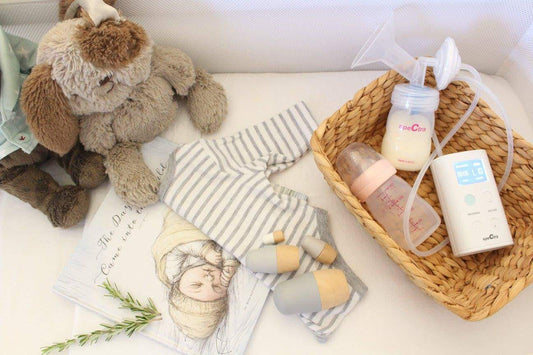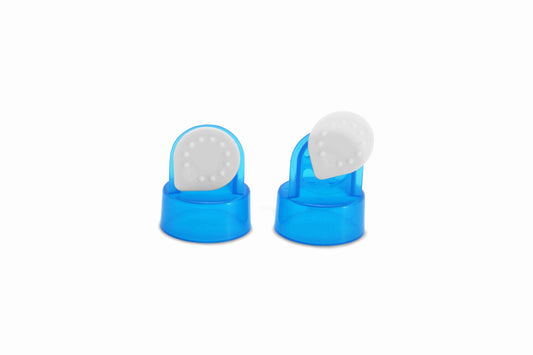Do I need to replace breast pump parts?
Lots of mums are not aware that some
breast pump parts do need replacing regularly to maintain performance. After a while some parts wear down and can fray or become over stretched and this results in a loss of suction when you are using your pump. Unfortunately, lots of mums will notice that the pump isn't working as well as it did, and think there's something wrong with their actual pump, or (even worse) that there's a problem with milk supply. Usually these problems can be easily resolved with a new part. If you notice that your pump seems to have lost suction, the first thing you should do is take a look at your parts, particularly the valves, and inspect for wear, fraying or stretching and replace if needed. Here’s a rundown of the pump parts you will need to replace on a regular basis, and how often to do so.
Valve membranes need to be replaced every 2 weeks to 2 months
The little white flaps on the valves need to be replaced regularly.
The membranes are made of silicone and over time will stretch and lose elasticity, which can impact suction power. Replace these every 2 months if you use your pump less than once a day, and replace every 2-4 weeks if using more frequently. If you ever see that the membrane doesn’t lay flat against the valve, it’s time to replace it, but it’s worth noting that damage is rarely visible in these small pieces. If your pump loses suction on one side, or you experience less suction when pumping, these membranes need replacement. The valve membrane needing replacement causes the vast majority of suction issues. Sterilising can also cause very fast deterioration, so always have spares on hand to change as needed.
Duck valves need to be replaced every 2 weeks to 2 months
If your milk collection kit has a
silicone duck valve, it needs to be replaced frequently as well. Replace these every 2-3 months if you use your pump less than once a day, and replace every 3 to 4 weeks if you pump more than once a day and about every 2 weeks if you exclusively pump. Duck valves last a little bit longer than valve membranes, but still tend to be easily damaged or worn from use and washing. Sterilising also can make these wear a lot faster, so always have spare valves on hand to switch when you notice you have a suction problem.
Backflow protector diaphragms need to be replaced every 3 to 6 months
Just like the valves, the diaphragms in the
backflow protectors can stretch and degrade over time, impacting suction. Replace these every 2 to 3 months if you pump once a day, and replace every 6 to 8 weeks if you pump more frequently. Inspect this part regularly before you pump because a torn, wet or damaged backflow protector diaphragm can allow moisture into the pump motor, causing irreparable damage and the potential for mould and bacteria to fester. Wash it in hot soapy water and let it air dry and ensure it is completely dry before use again. The backflow protector is the heart of a closed system pump and protect your baby’s milk from contaminants and bacteria that could cause harm, so take great care of these. If not changed regularly, they will impact suction strength, and risk mould and bacteria in your pump, and possibly your milk.
Tubing needs to be replaced occasionally
The backflow protector should prevent moisture from entering
the tubing. However, should moisture ever enter the tubing, we recommend replacing the tubing. There is no way to sterilise the tubing and it’s important to keep the tubing completely dry because moisture can cause damage to the motor. The ends of the tubing can also stretch out and degrade over time with use, which can impact suction performance of the pump. If the tubing slides on and off the backflow protector or pump motor easily, then it’s time to replace it. Note that it is typical for the tubing to slip off if you are moving around while pumping, or if the tubing isn’t secured tightly onto the pump motor or backflow protector. This is how it’s supposed to work, therefore not a sign of needing replacement. Just take care to notice if the tubing slips on and off considerably easy, then it may be time to replace.
Replace breastshields, bottles and teats every 6 months
Replace the
breastshield and all bottles and teats every 6 months. Keep an eye out for buildup of residue in cracks and crevices of the shield - sometimes the most rigorous cleaning routine is no match for hard to reach places, and over time buildup does occur. For this reason we recommend replacement every 6 months for hygiene reasons. And in general, always replace parts if you see they are torn, distorted, or cracked. It is worth noting that in plastic parts, sometimes discoloration can occur as resulting from the sterilisation process; this does not impact the usability of the parts and they do not need to be replaced when this occurs.
How do I dispose of old parts?
Breast shields, collection bottles, and other plastic components of your milk collection kit can be recycled by your local authority. Be sure to sterilise them first. Tubing and silicone parts like membranes and valves can be tossed in with your regular municipal waste. Pump motors can be recycled at a designated electronics recycling center in your area. Do not dispose of breast pumps in your regular trash.
Frequently Asked Questions
Q. I had another baby and I want to continue using my original breast pump. Is there anything I need to replace?
Milk collection kits, which include tubing, backflow protectors, valves and bottles should be replaced for a second baby. It’s best to start out with a brand new kit so you can better keep track of which parts need to be replaced regularly as recommended, and avoid gradual reduced suction over time which can occur in older parts - especially if they have been sitting unused for some time. As for the pump motor we recommend inspecting the functionality ahead of time by assembling and attaching the pump kit and visually inspecting that the backflow protectors are moving back and forth correctly. We recommend storing breast pumps in a cool closed off area free of moisture to prevent possible damage while not in use.
Q. I bought a second hand pump. What parts should I replace?
When buying second-hand, never buy milk collection kits - only buy the pump itself. There is no way of sterilising milk collection kits to make them safe for multiple users, ever. If you’ve purchased a second-hand pump, be sure to purchase brand new breast shields, bottles and backflow protectors for yourself.
Q. I’m sharing a pump; how often should I replace parts?
When you’re sharing a pump, you need to have your own milk collection kit. No method of cleaning or sterilisation can make milk collection kits safe for use by multiple users. That being said, follow the same guidelines as above for when to replace parts based on how frequently you use them.
Q. I’m only pumping a couple times per week - do I really need to replace parts as often as this?
Yes, to maintain your pump working correctly, and to ensure you are draining as much as you can each pumping session. The above guidelines are recommendations based on two types of pump users: those who exclusively express (mums who use their pumps 6-8 times per day), and those who pump 1-3 times a day (such as moms who pump and work and direct latch feed at home). If you pump less frequently than that, then you may find parts last a little bit longer - BUT, always pay close attention for signs of wear and tear including reduced suction, slurping noises, changes in shape, and tears.
Quick Glance Chart for Replacing Breast Pump Parts







